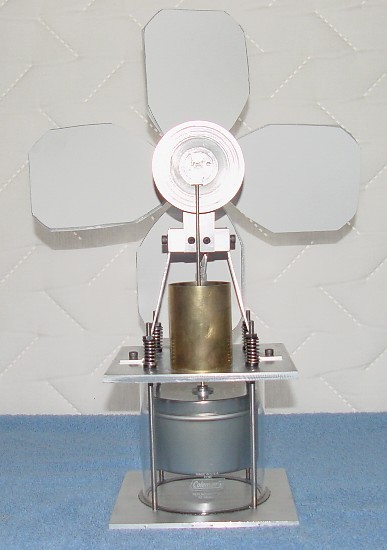The Gamma configuration drives the displacer directly from a crank shaft. Other than that, this engine is similar to the other two engines we’ve built (same basic structure, same displacer cylinder, same tower concepts, same fly wheels, same power pistons, same displacers, etc).

The crank mechanism is more obvious from the side.


A detail of the crank. From left to right: 1) the fan hub, made of aluminum, to minimize weight; 2) the counterweight wheel (with the cylindrical counterweight near the bottom), used to try to balance the engine (vs the weight of the displacer and power piston); 3) the left crank disk; 4) the right crank disk (you can just barely see the crank rod going between the two disks, and the displacer push rod coming up from below); and 5) the fly wheel and power piston crank wheel. The tower had to be redesigned to accommodate the displacer throw.

From the top. The white nylon fixture which connects the displacer to the crank rod can be seen in the middle of the picture, towards the right. The counter weight can also be seen between the counter weight disk and the fan hub, with the weight on the left. The power piston connections, including nylon clevis, can also be seen. Note that each disk can be adjusted with set screws.

The same, from above. The displacer crank connection is now visible on the left, and the counter weight is visible on the lower right.

The above crank configuration turned out to be too “sloppy”. There were so many set screws and adjustments, which resulted in the drive shaft wobbling quite a bit. There was only one bearing in each of the vertical tower extensions, and the two halves of the crank could never be made sufficiently coaxial.
Ralph helped me manufacture the crank shown below. The main drive shaft started out as a single piece of metal. We fabricated two brass plates with two through holes in each plate. The drive shaft was threaded through the holes and the plates were separated an appropriate distance. The crank rod was then threaded through the other two holes. The resulting parts were positioned carefully (in a fixture Ralph made) and then silver soldered in place. The part of the drive shaft between the plates was then cut out. The result is a crank shaft which runs true, even if it is a bit ugly. A brass split top part had to be made to attach the displacer rod to the crank rod.
This is the only picture to clearly show the slot which had to be milled in the top of the tower to allow the displacer rod to connect to the crank.
